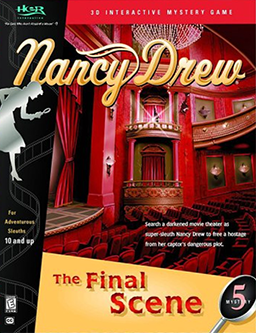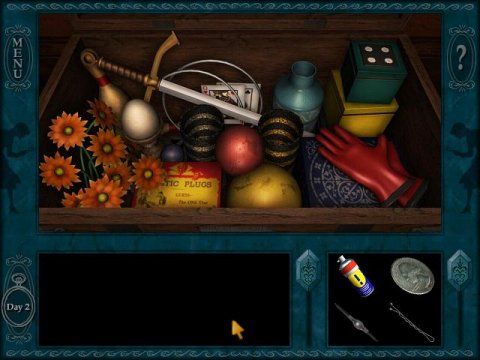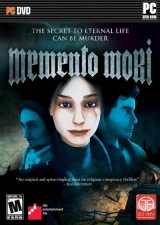Review for Nancy Drew: The Final Scene
In Nancy Drew: The Final Scene, the fifth game in the popular series, Nancy has once again found herself embroiled in a strange case--this time the kidnapping of her good friend, Maya. Nancy is the type of girl that in real life would have a nickname like ‘Disaster Drew’, due to all the strange events in which she finds herself entangled. However, in the game world, this particular skill gets her my vote for the title ‘Most Fun to Hang out With’, and for good reason. For it seems that no matter where Nancy goes, mystery seems to follow. In the case of The Final Scene, this is the Royal Palladium Theatre in St. Louis, Missouri. A once-glamorous staging ground for some of the world’s best magicians, in recent years it has fallen into ruin and is soon to be demolished.
Nancy accompanies Maya to the Royal Palladium because Maya had wrangled a one-on-one interview with the theatre’s current star, Brady Armstrong. But on Maya’s way to her interview she is kidnapped, leaving Nancy to discover which of the various untrustworthy characters in the theatre were involved. Was it Brady, with his insatiable thirst for stardom? Or could it have been Simone, his scheming Press Manager, whose motto is ‘no-publicity is bad publicity’? On the other hand, it might be Joseph, the Palladium’s long-time projectionist. As we all know, there isn’t much demand for projectionists these days. However, it might be Nick; the St. Louis President of Humans Against the Destruction of Illustrious Theatres (HAD IT). As leader of HAD IT, he might just be radical enough to resort to kidnapping to save the building. With this cast of characters to interact with, Nancy is never lonely long and gets lots of opportunities to put her detective skills to work.
I spent a great deal of time in my review of Treasure in the Royal Tower discussing the faults of that game’s interface. I won’t go into as much detail on this aspect of The Final Scene, except to say that the interface from game four has not changed for game five, giving the player a very confined game window to play in. This is because an inordinate amount of space is taken up by both inventory and dialogue boxes, thus using up space that could easily have been incorporated into the game environment. Because of this small gaming window, players may find that navigation isn’t as smooth as in other games. I often found I needed to place my cursor just about off the game window to go the direction I wished. Characters in this first-person perspective game can generally only move in the four directions, and the game relies on a traditional point & click interface for manoeuvring. There is nothing exceptionally groundbreaking about using this interface. Anyone should be able to sit down and play without the benefit of a manual.
I have always liked the fact that these games come with the option of playing as either a Junior Detective or a Senior Detective. It gives the games a versatility that many other titles don’t have. For example, whenever I finish one of these games I pass it onto my nephews, who play in Junior mode and find this just as satisfying an experience as I do playing in Senior mode. The fact that Nancy is a girl doesn’t seem to matter to them in the least; they just enjoy playing the games. One of the reasons for this is the delicate mix of puzzles these games often employ, and The Final Scene is no exception. There are lots of inventory items to collect, tons of characters to interrogate, a few simple slider puzzles to best, and a whole lot of snooping to do. These games are not puzzle-based titles like Myst; they are more like the Monkey Island games, where exploration, inventory gathering and character interaction are the primary way the story is driven and the action advanced. Because of this the puzzles that I did encounter were not overly difficult, but rather just took trial and effort to overcome.
The Final Scene uses a pretty typical looped soundtrack that was eerily reminiscent of the theme music from the Pink Panther. Coincidence? Somehow I doubt it… something about that soundtrack seems to have become iconic and directly identified with mystery, sleuthing, and adventure--all things the Nancy Drew games pride themselves on. The game does use some nice ambient sounds sporadically, but generally it is the looped soundtrack that plays with slight variation depending on when and where you are in the game. Unlike a lot of looped soundtracks, I didn’t find it annoying or overbearing, but the only time I found the sound added to gameplay was at the end, where its urgency signals that time is rapidly running out, so you may wish to take the cue and save your game in case you don’t piece everything together in time.
I have come to expect good things from the voice work in these games, and The Final Scene is no exception. Though the characters Nancy interacts with are not very dynamic, usually just standing very still and moving their mouths, the quality of the voice work that comes from them adds important dimension to the storyline. This story is very clearly developed through dialogue trees, and the more characters you talk to, the more information you get. I like interacting with different characters, but it seemed to me that I spent more time than usual conversing with different characters in this game. At one point I was almost wishing for a journal to read--almost.
The graphics in this game, or any Nancy Drew title, are not one of its strongest points. This game can’t compare graphically to a game such as Myst IV: Revelation, which has far superior environments to explore and detailed, layered graphics to enjoy. However, you are usually so engrossed in what is going on in the game, that you don’t tend to notice the lack of eye candy. The visuals may not be the brightest or prettiest graphics available today, but they are not shadowy or difficult to interpret, and they do basically what they were designed to do--tell the story. And because they do this very effectively, they are successful overall.
There are two constructive criticisms I have about the game: it is too short and it just doesn't have enough environments to snoop through. I finished The Final Scene in 12 hours in Senior Detective mode. This seemed lightning fast considering that the previous game took me about 20 hours to finish. I know that Her Interactive pumps outs two or three of these games a year; could this schedule be creating a situation where one game gets more development time than another? After playing this game, it sure seems that way to me. This is not to say that The Final Scene isn’t an enjoyable game; it just didn’t have as many environments to explore as the previous game. I was literally champing at the bit for more secret rooms and passages to discover, but sadly that didn’t happen. This is mainly due to the fact that all of the action in the game takes place in the Theatre, which is a very contained space.
While Nancy Drew: The Final Scene is not as strong a game as its immediate predecessor, it is still a largely entertaining game that fans will enjoy. The game really delivers in the areas of character interaction, story and voice work, which helps it to overcome a number of its shortfalls. And while the game’s interface is utilitarian, it is simple and straightforward to use. I really think Her Interactive has got a pretty good approach going with these games. If they can fix a few of the flaws identified in these early games, then I think they will continue to build a loyal following of both junior and senior detectives.


























